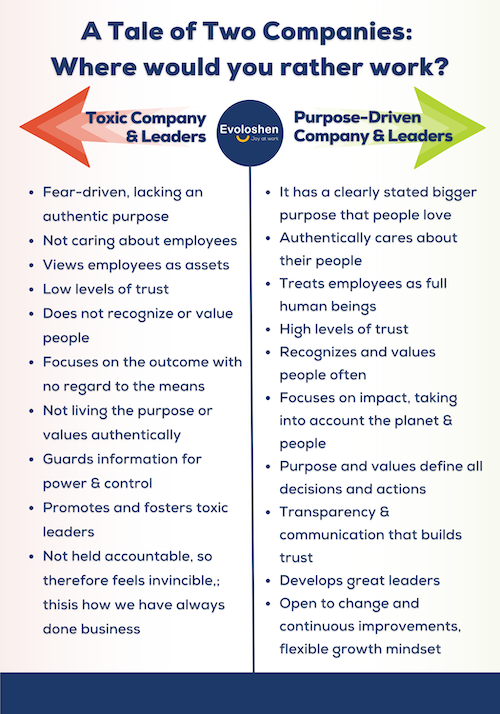Photo credit: Robert Stump/Unsplash
We are at a major fork in the road for business.
Being able to speak to a large global network of CEOs and CHROs openly about what issues they are facing in their companies is a gift. It gives me insights into what challenges are coming and how they are planning to tackle them.
One big trend I have seen during the last couple of years is a parting of the ways between two types of companies: toxic companies and purpose-driven companies. Let’s describe the two extremes and see if you can relate to these…
The Toxic Company
The toxic companies and leaders are solely focused on moving ahead, regardless of the ramifications. They might talk about purpose, values, and culture, but the behaviors and actions say something else. It is inauthentic and it shows. Both employees and customers can pick up on this, even if they do not verbalize it. There is a lot of whitewashing, and although the words might sound great, the reality is that people are not happy, they are actively looking to make a change, and the quiet quitting movement is hitting them hard. Their employees are stressed and feel uncertain and off balance most of the time. These companies and toxic leaders are often working to cover up the inadequacies. There is a high level of distrust. People will feel like they are walking on eggshells at work, keeping their head down, trying not to be seen, while they are struggling to survive in this environment. There is backstabbing and a mentality of a dog-eat-dog world. Working from home may have helped as they get the physical distance, but the toxicity still seeps through. They are hanging in there for the paycheck but not much else. They may feel stuck because they have obligations, and they need the income. And as soon as something better comes along, they will jump ship immediately.
The Purpose-Driven Company
Then we have the purpose-driven companies with leaders who truly care about their employees. These progressive leaders have created an authentic bigger purpose for the company that is the north star for all decisions and behaviors, and they are doing their best to live this out on a day-to-day basis. These companies tend to have a great culture and they offers a place of stability in a very chaotic world. People feel safe, they feel seen, valued, and cared for by their colleagues, managers, and leaders of the organization. In this company, there is a high level of trust and a willingness for everyone to do their best. People are generous with recognition. They are happy to do their work knowing that what they do matters. They are contributing to the greater good. They speak very highly to their friends and families about their work. And even if it may be stressful at times, they are proud of their progress and want to collaborate and make everyone look good. These employees feel emotionally connected to their company on a deeper level. They feel that they are making the world a better place, and it excites them to be a part of the journey.
Have you experienced either environment? It does not matter what industry, what geographical location, or what size of company—there are examples of both cultural extremes in all areas. Of course, there are also endless nuances in between. It’s possible to have a great culture yet a very toxic manager that is hiding it well. And you can have a great manager who is able to buffer the toxicity of the culture for their own team.
Gallup has said from their research that people join companies for the culture but leave because of poor managers.
Culture is a business asset. But many leaders have not been able to make this tangible. They do understand the importance but are not sure just how to work with the culture. And many leaders have their own blind spots in their management styles.
Culture cannot be forced! It exists, whether by default or by deliberate strategies and actions.
A great culture takes open-minded, caring leaders that want to focus on a people first approach to serve their customers and clients to their best ability. This leads to company growth, which is the most common goal for any company.
Amazing leaders who have figured this out and have transformed their organizations often want to share it with the world. It becomes a calling, a driver to get the word out. They write inspiring books, speak on stages around the world, invite other leaders to come and see what they are doing, and eventually some even start training programs to teach leaders that yes, they can do this too!
I believe we are seeing an evolution of leadership styles and organizational cultures. The companies that are purpose-driven, will thrive. They will attract the best talent and be able to easily reach their objectives. While the more toxic companies will struggle because they are losing great people and will not have the talent to do what they had hoped. Eventually, these toxic companies will fail. And what we will see instead is that great company cultures will become the norm, not the exception. That day cannot come soon enough!








